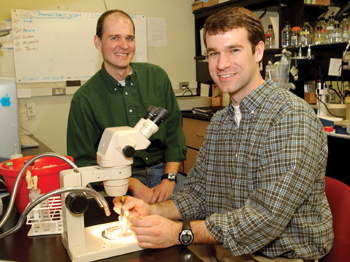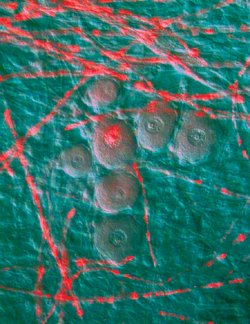
Bruce Carter, Ph.D., left and Josh Nickols are studying how nerve axons are coated with myelin, a critical step in peripheral nerve cell regeneration following injury and disease-related damage. Their findings were published in Nature Neuroscience. (photo by Dana Johnson)
VUMC team works to understand nerve regeneration

Crisscrossing myelinated axons are red in this picture of nerve cells growing in the laboratory. Vanderbilt scientists are using the nerve cell cultures to study the formation of myelin. (Image courtesy of Bruce Carter and Josh Nickols)
Spaghetti-like. That’s how Josh Nickols, a Neuroscience graduate student, describes the crisscrossing nerve cell axons growing in laboratory dishes. Nickols is using the nerve cell cultures to study the formation of myelin — a fatty coating on axons that enables rapid nerve cell communication and that is lost in diseases like multiple sclerosis.
Nickols and his mentor, Bruce Carter, Ph.D., assistant professor of Biochemistry, have identified a key participant in the production of myelin in the peripheral nervous system. Their findings, published Jan. 6 in the advance online version of Nature Neuroscience, have implications for understanding the mechanisms of nerve cell regeneration following injury and disease-related damage.
Myelin, it turns out, is both friend and foe to regeneration. In the peripheral nervous system, it promotes regeneration, but in the central nervous system (the brain and spinal cord), myelin inhibits the regrowth of nerve cells. That’s why spinal cord injuries leave sufferers paralyzed for life.
“If we can understand what’s different about the myelin in the central and peripheral nervous systems, then maybe we’ll be able to discover ways to promote regeneration in the central nervous system,” Carter said.
That’s where the nerve cell cultures come in. The cultures contain two kinds of cells — neurons and Schwann cells — both isolated from dorsal root ganglia, little bundles of peripheral nervous system cells situated near the spinal cord. Schwann cells produce myelin and wrap it around a single nerve cell axon, like toilet paper on its roll. Many Schwann cells participate in the myelination of one axon, each cell wrapping just a tiny length of axon.
How do the Schwann cells know to line up along an axon, to multiply, and to “mature” into myelinating cells? They are responding to a signal from the neurons, Carter said, but what that signal is and the pathways that are activated inside the Schwann cell are still mysteries.
“The whole process of how a neuron communicates with a Schwann cell to stimulate myelination is largely unknown,” Carter said.
Carter and Nickols focused on a protein called NF-kappaB, a so-called transcription factor that responds to signals from outside the cell and turns other genes on or off. They found that as the myelin formed in the co-cultures of neurons and Schwann cells, NF-kappaB was present at high levels, in its activated form.
In fact, it was not only activated in the cultures, but also in nerves growing in animals.
“NF-kappaB is highly upregulated early in development, during a timepoint at which we understand Schwann cells are just beginning to produce myelin,” Nickols said.
With the enticing idea that NF-kappaB could be driving the Schwann cells to produce myelin, Nickols and Carter examined what would happen if they blocked its activity, using a number of different pharmacologic and genetic approaches.
They found that when NF-kappaB activity was blocked, very little myelin formed. The Schwann cells still lined up along the axon bundles in the culture, but they failed to pick out a single axon and initiate the myelination process.
Because NF-kappaB also participates in cell proliferation and cell survival, the investigators went to great lengths — counting thousands of cells — to show that blocking NF-kappaB activity did not change the numbers of surviving or dividing Schwann cells or neurons in the cultures.
“It’s really amazing what we see in the cultures,” Nickols said. “Over the course of 10 days, you get these really nice spaghetti structures — the myelinated axons — coursing throughout the culture. But when NF-kappaB is blocked, you just see parallel bundles of axons with Schwann cells studded along the length.”
Without NF-kappaB activity, the Schwann cells still have a basic association with the axon bundle, he said, but they never invest themselves in selecting out a single axon and wrapping it in myelin.
The studies suggest that NF-kappaB is an essential part of the myelination program, Carter said. And he and Nickols are now searching for the signals that turn on NF-kappaB and for the genes that it, in turn, regulates.
“If we know that NF-kappaB is turning on a certain set of genes and that it’s unique to Schwann cells,” Carter said, “then maybe we can turn on some of those same genes or activate NF-kappaB to spark regeneration in the central nervous system.”
Also of particular interest is the role this signaling cascade might be playing in autoimmune diseases in which there is demyelination of nerves, for example multiple sclerosis. One theory for the cause of multiple sclerosis, Carter said, holds that the immune system is attacking and degrading myelin and is then damaging the exposed nerves.
“Most people think that cytokines (immune system proteins) are acting in a strictly negative way to cause damage to myelin, and that if we could block or eliminate them, we would be able to help people with multiple sclerosis,” Carter said. But cytokines also activate NF-kappaB, which the current studies show is important to myelination and therefore to the ability of the peripheral nervous system to regenerate, he added.
NF-kappaB may be both harmful and beneficial, depending on the timing of activation and the state of the cell, Carter said. “It’s likely to be very complicated.”
Complicated systems make for challenging research, Carter and Nickols agree. In their search for activators of NF-kappaB, one candidate is the nerve growth factor receptor p75. A group of investigators from Stanford University reported in Science in November that the p75 receptor is a positive modulator of myelination, and this receptor is known to activate NF-kappaB.
“It’s an exciting time in the myelin field,” Nickols said.
Co-authors of the Nature Neuroscience paper also include William M. Valentine, Ph.D., associate professor of Pathology, and Sujata Kanwal. The research was supported by the National Institutes of Health, the Christopher Reeve Paralysis Foundation, and the Wadsworth Foundation.













